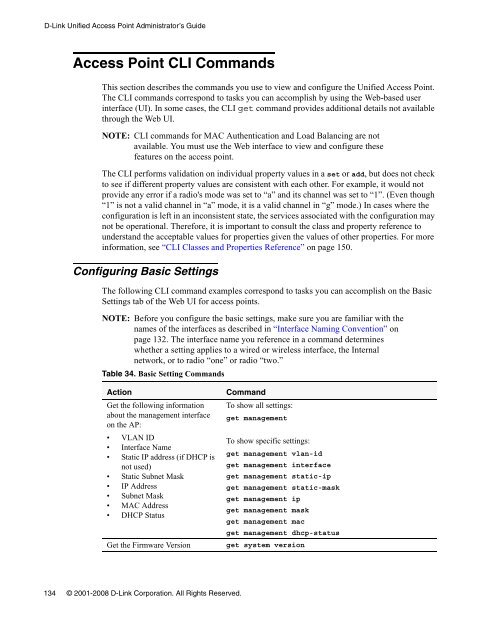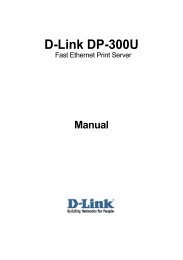Unified Access Point (AP) Administrator's Guide
Unified Access Point (AP) Administrator's Guide
Unified Access Point (AP) Administrator's Guide
Create successful ePaper yourself
Turn your PDF publications into a flip-book with our unique Google optimized e-Paper software.
D-Link <strong>Unified</strong> <strong>Access</strong> <strong>Point</strong> Administrator’s <strong>Guide</strong><br />
<strong>Access</strong> <strong>Point</strong> CLI Commands<br />
This section describes the commands you use to view and configure the <strong>Unified</strong> <strong>Access</strong> <strong>Point</strong>.<br />
The CLI commands correspond to tasks you can accomplish by using the Web-based user<br />
interface (UI). In some cases, the CLI get command provides additional details not available<br />
through the Web UI.<br />
NOTE: CLI commands for MAC Authentication and Load Balancing are not<br />
available. You must use the Web interface to view and configure these<br />
features on the access point.<br />
The CLI performs validation on individual property values in a set or add, but does not check<br />
to see if different property values are consistent with each other. For example, it would not<br />
provide any error if a radio's mode was set to “a” and its channel was set to “1”. (Even though<br />
“1” is not a valid channel in “a” mode, it is a valid channel in “g” mode.) In cases where the<br />
configuration is left in an inconsistent state, the services associated with the configuration may<br />
not be operational. Therefore, it is important to consult the class and property reference to<br />
understand the acceptable values for properties given the values of other properties. For more<br />
information, see “CLI Classes and Properties Reference” on page 150.<br />
Configuring Basic Settings<br />
The following CLI command examples correspond to tasks you can accomplish on the Basic<br />
Settings tab of the Web UI for access points.<br />
NOTE: Before you configure the basic settings, make sure you are familiar with the<br />
names of the interfaces as described in “Interface Naming Convention” on<br />
page 132. The interface name you reference in a command determines<br />
whether a setting applies to a wired or wireless interface, the Internal<br />
network, or to radio “one” or radio “two.”<br />
Table 34. Basic Setting Commands<br />
Action Command<br />
Get the following information To show all settings:<br />
about the management interface<br />
on the <strong>AP</strong>:<br />
get management<br />
VLAN ID<br />
Interface Name<br />
Static IP address (if DHCP is<br />
To show specific settings:<br />
get management vlan-id<br />
not used)<br />
get management interface<br />
Static Subnet Mask<br />
get management static-ip<br />
IP Address<br />
get management static-mask<br />
Subnet Mask<br />
MAC Address<br />
DHCP Status<br />
get management ip<br />
get management mask<br />
get management mac<br />
get management dhcp-status<br />
Get the Firmware Version get system version<br />
134 © 2001-2008 D-Link Corporation. All Rights Reserved.
















